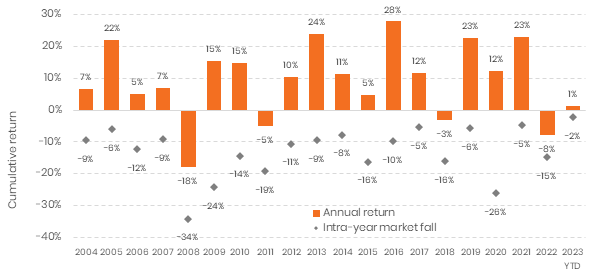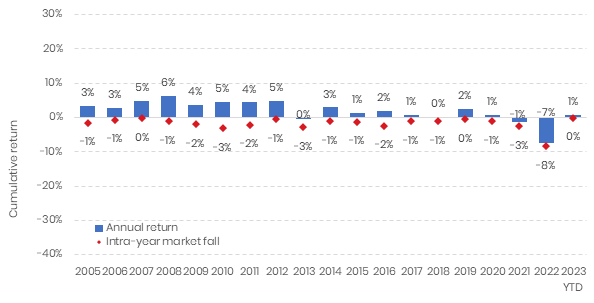Reacting to market falls
Being an investor is never easy because we tend to live in the moment responding to our emotions, the environment around us and the circumstances we find ourselves in.
9th February 2023
-
Gavin Jones See profile
Sitting here now, we may look at the looming global economic recession and prospects of rising interest rates to decide that selling everything and putting it under the mattress is a good idea.
As investors, it is important we remain focused on the long-term goals that we have and not on what is going on in the day-to-day, month-to-month or even year-to-year of the markets. This is evident from the two charts below.
Each of these charts show that if we listen to this daily economic noise, we would spend most of our time being afraid of investments instead of embracing them for the returns that taking on sensible risks should deliver.
In equity market parlance, a ‘correction’ is deemed to be a fall of 10% or more and a ‘bear market’ is a fall of 20% or more. The columns are the annual returns of the market, and the diamonds represent the magnitude of the fall from the market high in that year.
Global equity markets fall from a high every single year

Data: Morningstar in GBP (January 2023)
It is pretty evident that any investor looking to profit from this would need some amazing form of foresight to predict these short-term market movements, acting in advance of them happening and then getting back into the market again at the appropriate time. Simply reacting, post-event, to market falls will invariably be a losing strategy. In reality, at any point in time, all the information held by all investors trading in markets is reflected in current prices. Prices will therefore move only on the release of new information, which is by definition a random event.
Investors were reminded in 2022 that bond returns can go down as well as up. The same challenge in terms of reacting to falls in bond markets applies. In almost every year, bond markets fall from an intra-year high.
Global bond markets also fall from a high every single year

Data: Morningstar, in GBP (January 2023)
Trying to time when to be in or out of bonds – and presumably into cash – could result in eroding away the term and credit return premium that a sensible structure of short-dated global bonds hedged to Sterling has the opportunity to provide for those focused on longer term investment horizons.
Most investors – at some time – will be either tempted to time when to be in or out of investments – or wish they had when markets fall. It would be great to be able to capture the upsides and avoid the downsides, but that is wishful thinking. Remaining focused on your long-term goals, staying invested and rebalancing regularly in our view is the best strategy, for a simpler investment life and the likelihood of better outcomes.

